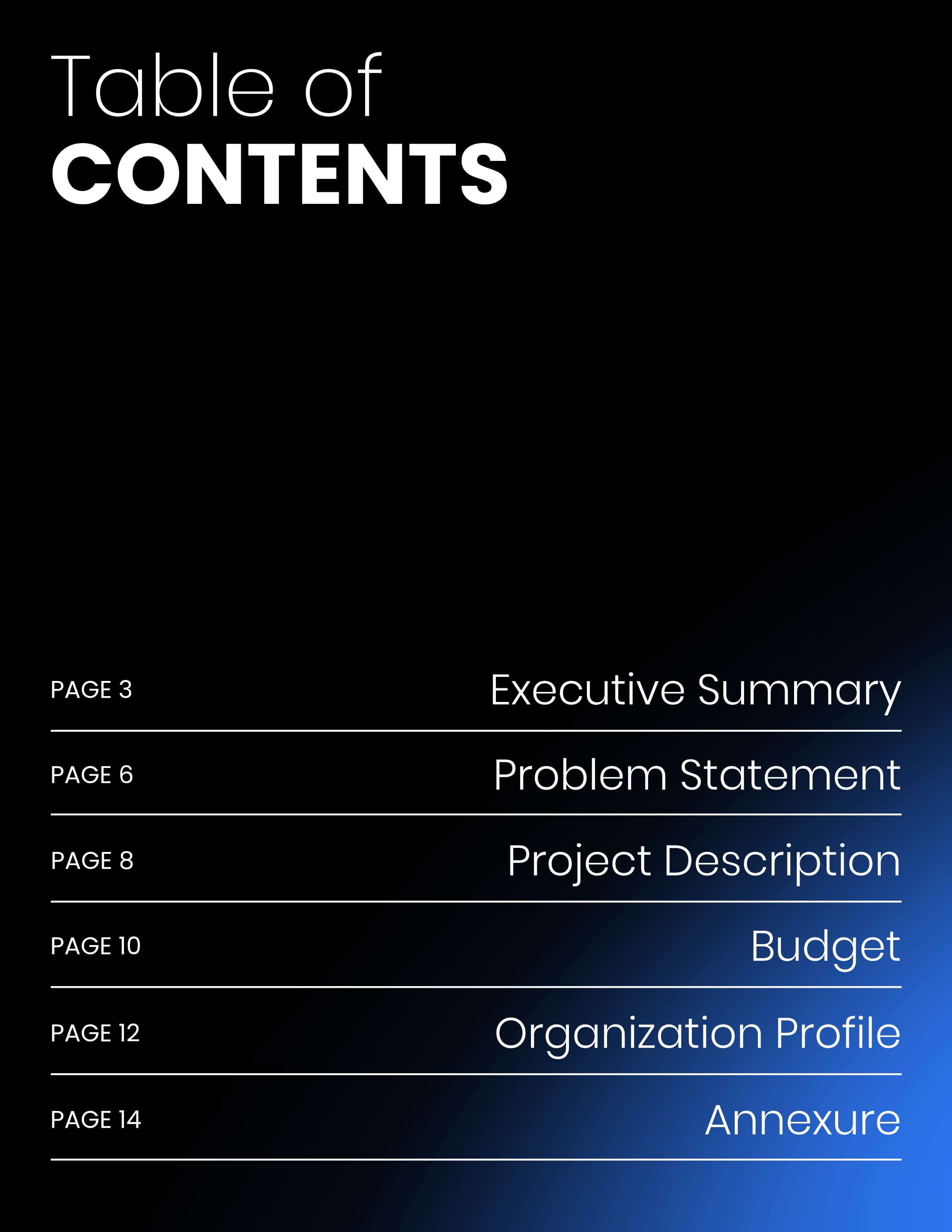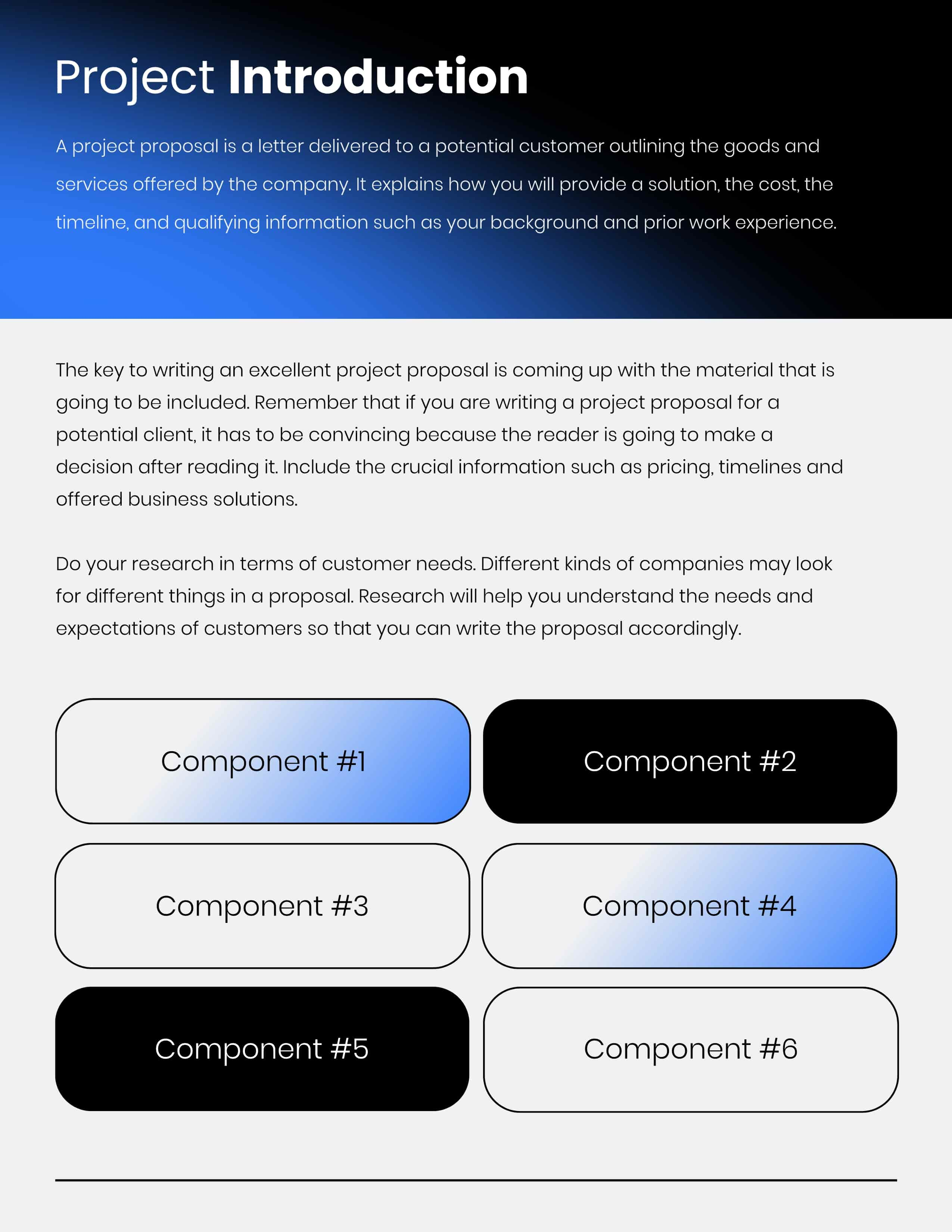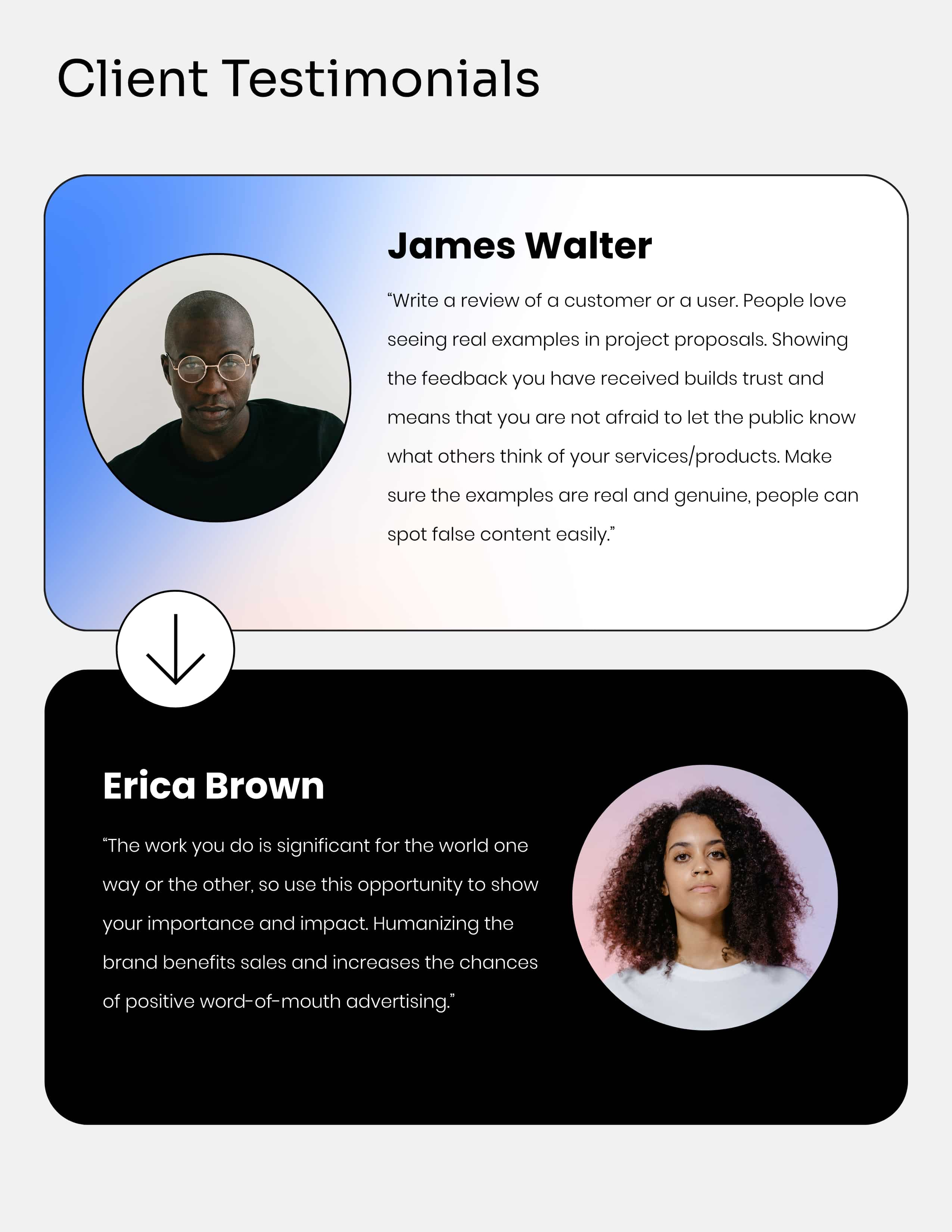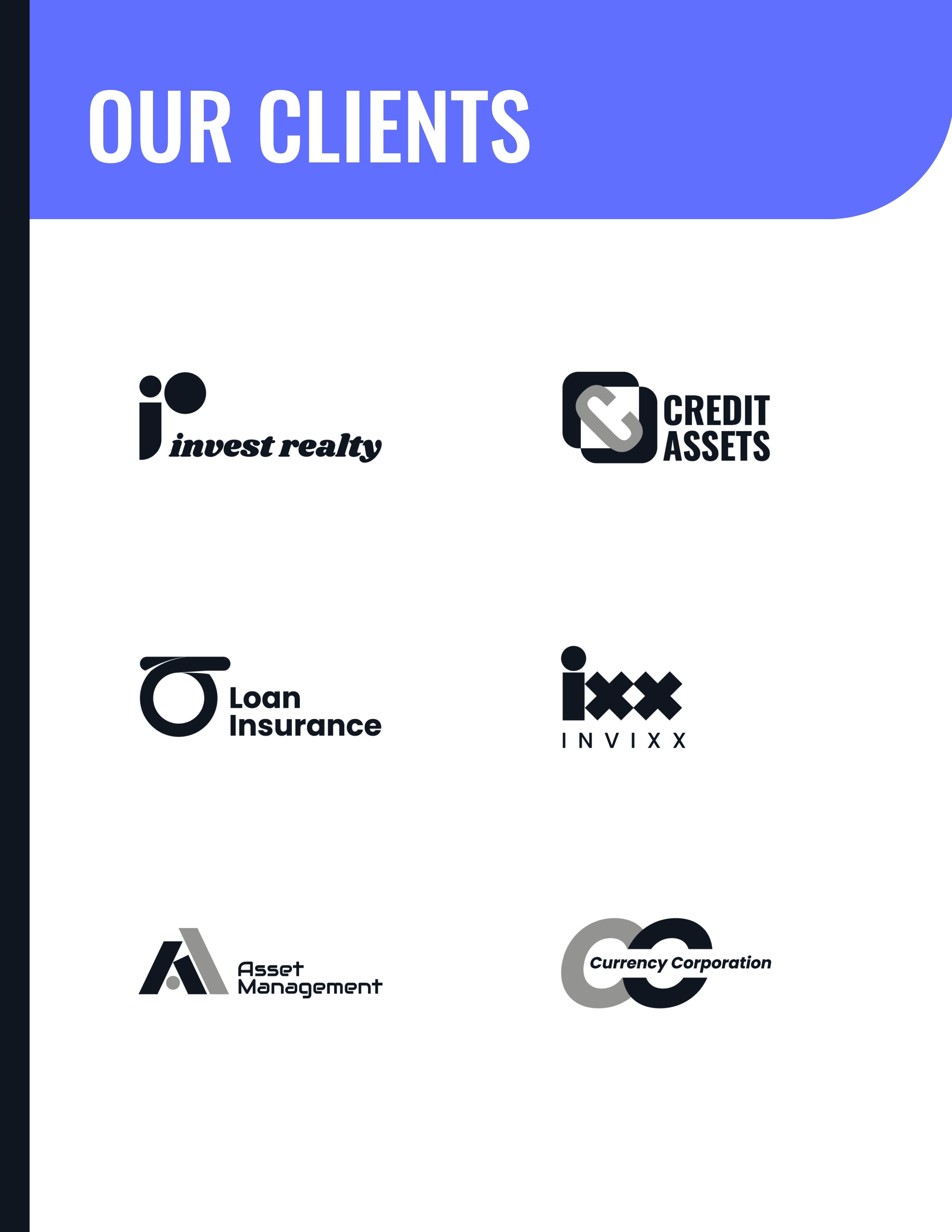
AI
They say you don’t have a second chance to make a first impression, which couldn’t be more true when writing a project proposal.
Project stakeholders don’t see who you are at the outset; they only see what you present in the Proposal. So, your goal is to make them see what you want them to see – a well-thought-out project with all details considered that’s worth investing time and money in.
Let’s guess the thought running through your mind right now: How to write a project proposal that enchants stakeholders?
Easy!
You just need to use project proposal presentation templates that are designed by experts in the field.
With a well-crafted one-page project proposal template, you can make the entire process easier for you and your team.
The stunning design is ready, all the project proposal rules are kept, and you are just tasked with filling in the necessary information to have your dream proposal ready in no time.
 |
 |
 |
A project proposal is a formal, written document to provide the audience with detailed information about a project. It should outline the purpose of the project, its goals, deliverables, budget, and timeline for delivery. In other words, the project proposal outline should include every detail that may interest stakeholders.
The project proposal presentation’s goals can differ based on the scope and scale of the project. It might be a marketing proposal to launch a new product line or an internal business plan to streamline processes. Regardless of what it is, a project proposal should be clear, concise and deliver the necessary information to help make well-informed decisions.
The most common intents of a writing project proposal include the following.
No matter the purpose, some common approaches and rules apply to every project proposal to ensure it is well-crafted and effective. Let’s see the main types of proposals.
The most formal project proposal example is sent in response to the client’s formal Request for Proposal (RFP). Usually, it’s when project owners are interested in specific services or products from certain parties and want to see what potential suppliers offer.
If you construct a solicited project proposal, be prepared to compete with other bidders. In this case, your project proposal outline should be very attractive, ready to stand out and make an impact. You should think about how to make your Proposal unique to get the edge you need of the competition, as there will be a detailed comparison of proposals.
In the case of unsolicited project proposals, there is no formal request from a project owner. For example, you can decide to participate in the open bid for a certain project and send in your project proposal even without a specific request.
Compared to the previous project proposal example, this one is less competitive as there is no direct comparison of bidders.
However, you still need to ensure your Proposal is attractive and visually pleasing as you again want to make a great impression and receive the client’s approval. Unsolicited project proposals also have “softer rules” regarding outline and format, as you don’t have to consider strict requirements from the client.
Often, your client can refer you with an informal request to send him a project proposal. This can refer to cases when you negotiate with a potential customer, and they get interested in more details about the offer you can provide.
In this case, you can craft a less formal project proposal, which can even be presented as a short presentation or a one-pager document organized in free form. Here, your main goal is to be informative and detailed enough so that you are on the same page about all the project details and responsibilities.
Let’s say one project was already completed, and the client is coming back for more with a request to renew your project, or you want to refer to an old and kind partner with a special offer to return and collaborate.
In this case, you should create a Renewal Project Proposal, ideally showing what was improved since the last time, what new ideas you have to offer, and why your project is still relevant for this particular client.
Renewal project proposals are usually based on the previous project proposal outline with the client to keep some consistency and make parties comfortable with each other.
Probably, this can be called one of the “easiest” project proposals as there is almost no competition here, and the client already knows you well. Moreover, there is no need to convince someone to start a new collaboration, as you already have an established partnership, and you prolong it.
Continuation project proposals are used when one phase of the project approaches the end, and you are asked to make a new proposal for an additional period. In this case, you must adapt the old project proposal outline and add new deliverables.
Even if your previous project proposal outline was already approved and the needed stakeholders got into the collaboration, you can still find yourself in a situation where you need to add something new.
For example, you can feel the need to write a project proposal asking for additional investment or more stakeholder engagement based on the new requirements. In this case, you should write a supplemental project proposal explaining why additional resources are needed and what improvements they can bring.
The main idea here is to show the client that your Proposal is still relevant and you need extra help and support to achieve a better project result.
Writing project proposals now is a simple task thanks to the abundance of ready-made templates, formats, and samples on the web. You no longer need to reinvent the wheel and waste time crafting a professional design, thinking about the text layout, etc.
Renderforest – an all-in-one design platform that provides you with project proposal templates for any industry. No matter what you need, which business field you are working in, and which terms and conditions you must consider, Renderforest got your back!
 |
 |
 |
But before you pick the right template, you should know some crucial principles of writing a project proposal. Here is the complete list of steps you should follow to write a project proposal that will bring results.
Proper research is the unsung hero of any successful proposal. It may be one of the invisible parts of the process, but it is one of the most important. Just as you need to lay a proper foundation for the building before you start constructing it, you need to create solid research about the project before starting to write a proposal. Otherwise, no matter how many attributes you add to the weak base in the future, it won’t bring any success.
So, give yourself enough time to research the project in every aspect. Don’t stop until you’re 100% sure you clearly understand what is needed.
Further, determine who the project benefactors are and what’s the best way to show the value of your project to them.
If these steps are successfully completed, project goals and objectives will be set, and you’ll better understand what the project should look like in the end.
So, give your mind the needed time for research and move to the actual writing process when the skeleton is ready.
Now coming to an arduous task – conveying project meaning, depth, and nuance in a short executive summary. When you do extensive research, and your brain is full of hundreds of project details, it takes work to summarize all this information in a few sentences.
Nevertheless, the executive summary is a standard and a crucial component of a project proposal outline, so you must master the art of writing it.
The executive summary is a concise but informative synopsis of the project. It usually contains the following sections.
Many responsibilities lie on your shoulders in this section, as that’s the first part readers will see when opening the project proposal. So it’s tasked to hook project owners and promise them something extraordinary that will get them interested in further document exploration.
You can even consider writing the executive summary at the end after all your project proposal is completed. This way, you can see the whole picture and summarize the whole idea in one paragraph more accurately.
Getting down to the nitty-gritty, you should start revealing more details about the project. Start with the project background, which is a detailed explanation of the reason behind the project, the current state of the problem for which this project is intended to solve, etc.
For example, if you’re intended to run a social awareness campaign about the importance of clean water, you should mention what kind of problem it is and why awareness is important to solve the issue. You can also include statistics about the current state of water scarcity or quality in the area your project will target.
Aside from covering the current state of the problem, the project scope should include the following.
You should also include a detailed description of the tools and methods you will use to complete the project. Here, an established work breakdown structure (WBS) can help significantly.
Well, when writing a project proposal up to this point, you have already talked enough about the project and why it matters.
But, there should be a detailed section for project objectives – not an abstract overview of what you want to achieve, but the exact points you need to reach.
In this regard, the widely popular SMART methodology is quite handy. It’s the acronym for Specific, Measurable, Attainable, Relevant and Time-bound objectives. Let’s spread the light on each of these points.
So many talks about why the project is important and which issue can’t stay unsolved. So, what should be your next move when writing a project proposal? Yes, solutions; actually, what’s your main project promise about?
The solutions section may be shorter than the previous ones, but it should be impressive and honest. Going back to the stage of project research, you should have a clear idea of what steps you need to take in order to come up with the desired result. If there is no clear plan you feel can lead to success, think again about whether you should launch the project.
But as you’re here, it’s most probably because you are equipped with the right methods and knowledge to do the job. So, what should be included in this section?
Gradually approaching the main goal of your Proposal – you need to engage the necessary resources from stakeholders, and of course, you need to explain why they should do so.
Conducting a thorough needs assessment is essential to identify the resources necessary for the project and why they are needed. First of all, it’s crucial for you to ensure you can complete the promised activities. Further, it’s crucial to include it in your project proposal outline, so chances of getting funding are higher.
When writing about needs assessment, you should include the following:
Foreseeing the unforeseen is the special mission of every project manager. When writing a project proposal, you should ensure you have a reliable contingency plan ready to be used in case of any disruption.
This plan should be included in your project proposal outline. Otherwise, your plan will not look reliable enough for investors, and they won’t be convinced that you can handle any disruption in a timely manner.
You should carefully brainstorm all the key risks that can happen during the project, as there are no standard templates for risk accounting. To identify the risks, you should take into consideration all the possible factors that can influence or derail your project completion.
Further, you should prioritize those that are more likely to happen and those which are real to prevent and mitigate. You should also show in the project proposal that you have a plan for responding to each possible risk.
Well, it’s almost time to congratulate you on a job well done! One last piece is left – the project conclusion, which should be compelling enough to motivate the reader to act.
The conclusion should restate your main points and capture what makes your project unique. It can also be used to include some graphs, reports, charts, or any other kind of data that supports your claims but was left out from the main body of your project proposal.
These are all the steps you need to take to create a winning project proposal outline. Now that you know the inside out of writing a project proposal outline, it’s time to explore some ready outlines which you can easily customize and use for your project.
Every project proposal you need is stored in Renderforest’s project proposals library. Creating a professional-looking project proposal with these ready-to-use templates is very easy. Here’re some you can try now!
Looking for a professional and modern business proposal template? Look no further! Our Business Proposal Template features the design and layout applicable for formal presentations where the emphasis should be placed on content rather than design.
 |
 |
 |
Moving to a more universal and casual project proposal template that can be a great fit for any project. It has detailed scenes describing the background of your project, the goals and objectives you set for it, and the timeline and resources you need to complete it.
 |
 |
 |
Colorful, dynamic, detailed – everything you imagine a modern marketing proposal should be is wrapped in this template. Its striking design will capture the attention of your potential audience, while its content will surely convince them to consider investing in your project.
 |
 |
 |
A project charter is an official document that marks the beginning of a project which can be created only after the project proposal is created and approved. So, if the project proposal is a persuasive document that is meant to get approval for your project, then a project charter is an official document that contains the details of the resources and timeline needed for completing your project.
They are different in purpose and the time when they are created. Nonetheless, both are must-have documents for successful project management, and both contain crucial details about project objectives and other details.
It’s not the word length that matters, but how detailed and convincing your project proposal is. You’re not limited to having a long project proposal if you keep it structured and concise.
Renderforest’s project proposal templates are constructed according to the key principles of project proposals and optimally cover all the important information in a few pages. You can use them as a starting point to craft your own project proposal quickly and easily.
Project proposals are the formal way to show project owners you’re the perfect team for the job. It’s a detailed and well-structured document with project objectives, timelines, and resources needed for successful completion.
Though designing a professional-looking project proposal is an easy task with ready-to-use templates, the content that goes inside is what really counts. You need to be precise and persuasive, consider every detail, and account for all possible issues when writing a project proposal outline.
Remember, its goal is not just winning the project but also laying down the framework to guide you through completing it.
Good luck in the ocean of project proposals!
Article by: Renderforest Staff
Dive into our Forestblog of exclusive interviews, handy tutorials and interesting articles published every week!
Read all posts by Renderforest Staff

